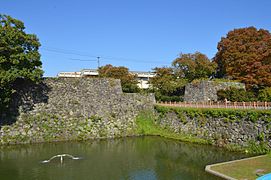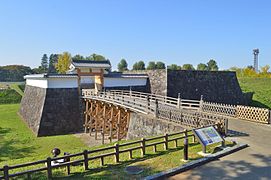Yamagata Castle
| Yamagata Castle | ||
|---|---|---|
|
Yamagata Castle East Gate ( 東 大 手 門 , Higashi-Ōtemon ) |
||
| Castle type : | Hirajiro (Lower Castle) | |
| Conservation status: | Partly reconstructed | |
| Place: | Yamagata | |
| Geographical location | 38 ° 15 '12.8 " N , 140 ° 19' 44.6" E | |
|
|
||
The castle Yamagata ( Japanese 山形城 , Yamagata-jō ) is located in the city of Yamagata , Yamagata Prefecture . In the Edo period , thirteen large, medium-sized and smaller Fudai daimyo resided there one after the other .
Lords of the castle in the Edo period
- Mogami with an income of 240,000 koku
- Torii from 1622 with an income of 200,000 koku
- Hoshina from 1636 with an income of 200,000 koku
- Matsudaira (Kamon) from 1644 with an income of 150,000 koku
- Matsudaira (Okudaira) from 1648 with an income of 150,000 koku
- Okudaira from 1668 with an income of 90,000 koku
- Hotta from 1685 with an income of 10,000 koku
- Matsudaira (Kamon) from 1668 with an income of 10,000 koku
- Matsudaira (Okudaira) from 1692 with an income of 10,000 koku
- Hotta from 1700 with an income of 10,000 koku
- Matsudaira (Ogyū) from 1746 with an income of 60,000 koku
- Akimoto from 1767 with an income of 60,000 koku
- Mizuno from 1845 with an income of 50,000 koku
The last daimyo, Mizuno Tadahiro ( 水 野 忠 弘 ; 1856-1905) was transferred to Asahiyama ( province of Ōmi ) in 1870 , where he had to be content with a "permanent house".
investment
According to tradition, the son of the explorer of the north of Honshū, Shiba Iekane, Kaneyori moved to Yamagata at the beginning of the Muromachi period and built a castle there. The Shiba then called themselves Mogami and ruled the province of Dewa. Kaneyori's son, Yoshiaki rose to daimyo during the Sengoku period . Yoshiaki expanded the castle between 1592 and 1615 and gave it its present size. After the Mogami was deposed in 1622, Torii Tadamasa took over the castle and carried out additional construction work. After that, the lords of the castle changed eleven times, they either belonged to the Tokugawa family as kamon ( 家門 ) or were Fudai daimyo .
The castle was built on a fan-shaped square between rivers, with further moats around the rectangular castle center (hommaru) surrounded by a moat. The castle was protected by earth walls, only the entrance area to the castle center was given a stone wall. At the time of the Torii, the center was the residence, which was protected by ramparts and a three-story watchtower, four two-story and one single-story watchtower. As the following lords of the castle had increasingly lower income, the preservation of the castle became more difficult over time. When the Akimoto became lords of the castle in 1767, they moved the residence in front of the east gate.
After 1868 the castle was demolished. The second moat was preserved, it is crossed in four places, as in the old days, with the east gate being largely restored. Of the inner moat that surrounded the central castle area ( Hommaru ), only the south-east area is preserved as a dry moat. The gate system, the Ichimoji-mon ( 一 文字 門 ), which leads to this inner area, has been restored .
The castle area is mainly used for sports today. In the north there is a baseball field and the “municipal archery practice area” ( 山形 市立 弓 道場 , Yamagata shiritsu indō-jō ). There is a sports hall behind the south gate and the Yamagata Prefectural Museum ( 山形 県 立 博物館 , Yamagata kenritsu hakubutsukan ) in the eastern part .
photos
literature
- Mizoguchi, Akihiro: Yamagata-jo in: Miura, Masayuki (Ed.): Shiro to jinya. Tokoku-hen. Gakken, 2006. ISBN 978-4-05-604378-5 , p. 38.






